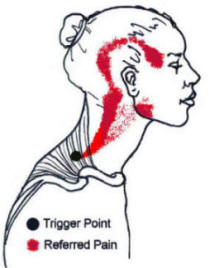Myofacial Pain
Commnest cause of body pain
Myofascial Pain Syndromes and Trigger Point Injection Therapy Dr John Whiteside MBBS, BSc
Perpetuating Factors
Introduction
In order to understand perpetuating factors you need to understand the global nature of myofascial trigger points. Skeletal muscle is the largest
single organ of the human body. It accounts for more than 40% of the total body mass. As we progress through life taut bands develop within skeletal muscle as a normal part of the
aging process. Along each taut band is a more sensitive region that is designated as a trigger point. Trigger points can exist in different stages of sensitivity. If they are
very sensitive they are active. If they are not very sensitive they are latent.
Active myofascial trigger point
Refers a pattern
of pain at rest or at motion.
Usually refers pain on direct compression.
Mediates a local twitch response.
Tender to palpation.
Prevents full lengthening of muscle.
Weakens the muscle.
Latent myofascial trigger
point.
Clinically quiescent with respect to spontaneous pain.
May refer pain.
Tender to palpation.
Prevents full lengthening of muscle.
Weakens the muscle.
They accumulate from all of the vast number of physical things that happen to us.
If all our trigger points remain latent we gradually become stiffer and weaker.
If
some become active we experience myofascial pain.
Prevalence
In general practice it is my experience that approximately 70% of all pain is primary Myofascial in origin. The remaining 30% has another cause but is normally associated
with a secondary myofascial pain syndrome.The ratio will depend upon two things.
The group of patients being examined
The experience of the examiner.
Sports
Injuries
Almost all are due to taut bands.
Muscle tearing is sometimes present as an associated event.
The associated muscle tear is self limiting.
Treatment
should be directed at the taut band not at the tear.
Treatment of all sports injuries.
Heat ASAP.
Never ice.
Stretch.
Ischaemic
pressure / massage.
Mobilization.
The Pain
Management Industry
The pain management industry internationally has been directing itself at "part of" "30 % of" the problem. This is why it is called a pain management
industry. " We cannot remove your pain but we can teach you how to manage it."
It is my opinion that as myofascial therapy becomes a routine part of the day to day
work of health care professionals then we will become a pain treatment industry.
Reasons why myofascial therapy fails.
The interdisciplinary myofascial team is
not sufficiently skilled.
Treatment is being directed at a secondary myofascial pain syndrome.
Perpetuating factors are present.
Perpetuating Factors: Any physical,
chemical or psychological factors that act to increase trigger point activity in that individual, at that particular time.
The following notes provide brief
practical information about some of the perpetuating factors.
The detail of this subject is in chapter 4 of vol.1. of the Trigger Point Manual.
Leg Length
Discrepancy (LLD)
The problem of leg length discrepancy (LLD) and the method of assessment is covered in detail in chapter 4 of vol. 1 and chapter 4 of vol. 2 of the
Trigger Point Manual.
Trigger points in the quadratus lumborum muscle must be released before an accurate measurement of LLD can be made.
The following is the
protocol used at my clinic.
At the initial assessment
Assess LLD
Assess quadratus lumborum bilaterally for trigger points.
If the quadratus lumborum muscles are not
shortened and if no confident diagnosis of LLD can be made, do not proceed to a trial of correction.
If a provisional diagnosis of LLD is made, with or without tight quadratus
lumborum muscles, reschedule the patient for a separate session to begin a trial of correction.
Release quadratus lumborum using procaine injection, spray &
stretch, & heat. Re-assess the LLD. Proceed to a trial of correction. If a LLD can be confidently diagnosed an initial trial correction can be made in the office be cutting a heel
raise from sheets of ethyl vinyl acetate (EVA). EVA can be purchased in different thickness from 1mm upward. Using scissors, Stanley knife, and glue the heel raise can be made
to the thickness required by sticking appropriate layers together.